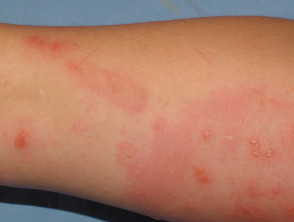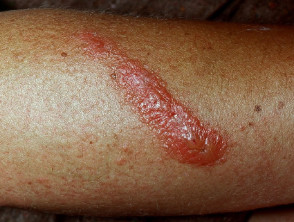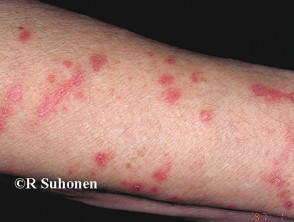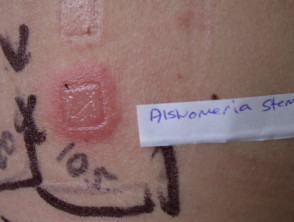Introduction
The prevalence of hand dermatitis among florists is between 8% and 46% according to various international studies. Dermatitis accounts for around 90% of all cases of occupational skin disorders in florists.
Why do florists have skin problems?
Florists have a tendency to skin problems because of their continued exposure to plants, which cause mechanical injuries and contact dermatitis.
Understanding the causes of occupational skin disorders
The skin interfaces with the environment and acts as a protective barrier against injury, bacteria, viruses and chemical irritants. However, certain occupations can lead to compromise of the epithelial barrier and to the subsequent development of skin disease.
Skin disorders related to professional florists
The following skin disorders are common in florists.
Mechanical injury
Mechanical injuries — such as abrasions, punctures and cuts — are caused by:
- Thorns
- Spines
- Razor-edged leaves
- Hairy appendages of plants.
Wounds in florists can become secondarily infected by bacteria, viruses or fungi.
Phytophotodermatitis
Phytophotodermatitis is caused by exposure to a plant containing psoralens and then to ultraviolet light, and is not an allergic reaction. The affected skin often remains hyperpigmented for months after exposure. The rash may blister and is frequently streaky in appearance.
Irritant reactions
Irritant contact dermatitis is caused by contact with various chemicals in plants, which include:
- Acids
- Calcium oxalate crystals
- Proteolytic enzymes.
Signs and symptoms of irritant contact dermatitis include red, blistered, scaling or cracked skin (dermatitis). Dermatitis caused by contact with plants often results in irregular, streaky or linear plaques.
Allergic contact dermatitis
Allergic contact dermatitis is relatively common in florists. It requires sensitisation of the person's immune system to a specific plant chemical. Patients without this sensitisation are not vulnerable to dermatitis. The reaction may be delayed for 10 days or so when primary sensitisation has occurred. It occurs within a day after subsequent exposure to the chemical.
Common sensitisers are primin (found in primula, or primrose species), sesquiterpene lactones (found in compositae species) and tulipalin a (found in tulips and alstromeria species).
The signs and symptoms of allergic contact dermatitis are similar to those of irritant contact dermatitis, but the rash may spread to sites that have not been in direct contact with the responsible plant.
Contact dermatitis to plants
Contact urticaria
Contact urticaria can be due to allergic or non-allergic causes.
- Urticarial weals arise rapidly on contact with the responsible agent and will resolve within an hour
- Non-allergic contact urticaria to the chemicals in plants can occur in anyone who is exposed; allergic reactions only occur people that are allergic to the plant.
Sporotrichosis
Sporotrichosis is a fungal infection caused by Sporothrix schneckii species.
- The sporotrichosis mould is commonly found in soils, plants and decomposing vegetation (like compost).
- Cutaneous infections occur when the fungus enters into the skin through minor cuts, scrapes or abrasions.
- While cutaneous infections are the most common form of sporotrichosis, the infection can be respiratory if spores are inhaled, and can also spread to bones, joints and the central nervous system.
- Patients with cutaneous sporotrichosis present with red, pink or purplish nodules on hands, fingers, forearms or other exposed areas.
Workplace risk assessment
Workplace risk assessment may help prevent occupational skin problems. Employees should be taught about the physiological properties of skin and its vulnerability, and about agents that can cause dermatitis — including phytochemicals. Employers should have controls in place on the worksite to reduce chances of dermatitis and know what to do if an employee develops a skin condition.
If possible, a “zero contact” policy should be strived for.
- Substitute products that cause dermatitis for ones that do not
- Engineering controls like proper ventilation
- Supply proper tools and personal protective equipment to increase employee safety.
Personal protective equipment
Gloves are the most common form of personal protective equipment and, if used properly, can help to protect the skin against irritants and sensitisers.
Drawbacks to glove use include:
- Employees must know what kind of glove is appropriate for what kind of work and the proper ways to inspect, don and dispose of the gloves
- Employers may have to stock several different kinds of gloves for the workplace
- The gloves themselves can cause contact urticaria (eg latex) or dermatitis (due to contact allergy to rubber accelerants).
Hand care advice for florists
In order to take care of their hands, it is recommended that florists:
- Use gloves when appropriate
- Do not wear gloves for more than an hour at a time, especially disposables
- Wash hands with mild soap or nonsoap cleanser as needed, and dry thoroughly but not roughly
- May use lotions or creams as needed
- Are advised to seek advice from a doctor if they develop dermatitis.
Diagnosis of occupational skin disease
Accurate diagnosis is based on meticulous patient history, knowledge of material data safety sheets, and patch testing to confirm contact allergic dermatitis.
Criteria for the diagnosis of occupational dermatitis include the following:
- Clinical appearance of the rash
- Possibility of workplace exposure to a potential irritant or allergen
- Anatomical distribution of the rash consistent with exposure to an occupational contactant
- Consistent time lapse between exposure and onset
- Elimination of the likelihood of non-occupational exposure
- Patch or provocation tests that implicate specific workforce exposure.
Treatment for occupational dermatitis can include:
- Wet dressings for oozing dermatitis
- Topical corticosteroids for dermatitis
- Oral antihistamines for urticaria.



